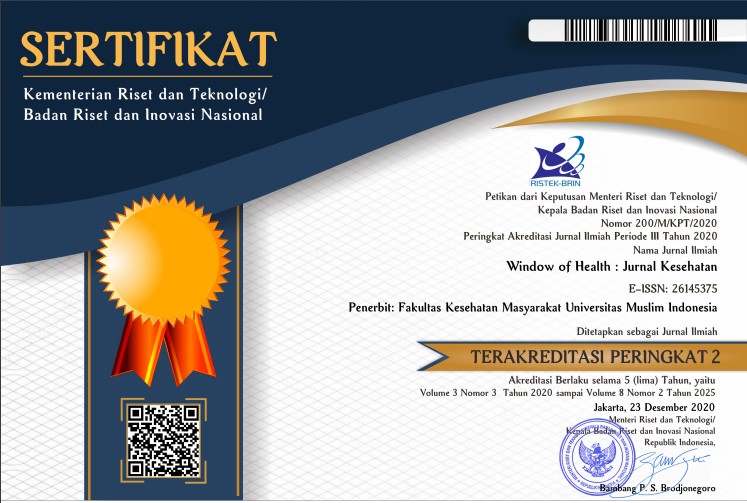Correlation Between Body Mass Index, Waist Circumference, and Body Fat with Oxidative Stress in Obese Adolescents
Abstract
Teenagers are one of the age groups that are prone to obesity. Obesity experienced by adolescents is a nutritional problem that is increasing rapidly and has become a significant public health problem. Obesity occurs due to an imbalance in energy intake over time, resulting in excessive fat accumulation and weight gain. This study aimed to identify the relationship between body mass index (BMI), waist circumference, and percent body fat with markers of oxidative stress in obese adolescents. The research method is an experimental research. The subjects of the study were 24 adolescents aged 13-15 years. Data were collected using a questionnaire and analysis of malondialdehyde (MDA) and superoxide dismutase (SOD) levels in the subject's blood serum. In addition, data in the form of BMI, percent body fat, waist circumference, pattern, and level of food consumption. Data analysis was carried out descriptively and inferentially at the significance level to determine the differences in treatment using the t-test if the data were normally distributed and the Mann-Whitney test if the data were not normally distributed. The closeness of the relationship was found using the Pearson correlation test. The results showed a moderately significant negative correlation between percent body fat and serum MDA, but body mass index and waist circumference were not significant. The higher the percentage of body fat, the lower the serum MDl. There is no significant relationship between BMI, LP, and % LT with serum SOD.
References
2. Vincent HK, Taylor. Biomarkers and Potential Mechanisms of Obesity-Induced Oxidant Stress in Humans. Int J Obes 2006;
3. Codoner-Franch P, Boix-García L, Simó-Jordá R, Castillo-Villaescusa, Del C, Valls-Belles, et al. Is obesity associated with oxidative stress in children ? Int J Pediatr Obes 2010;
4. Savini, Catani, Evangelista, Gasperi, Avigliano. Obesity associated oxidative stress strategies finalized to improve redox state. Int J Mol Sci 2013;
5. Kurdianti W. Faktor-Faktor yang Mempengaruhi Obesitas Pada Remaja. J Gizi Klin Indones 2015;11:179–90.
6. Nurun N. Hubungan Konsumsi Serat Pangan dan Kejadian Obesitas Pada Mahasiswa Fakultas Kedokteran Universitas Sumatera Utara. Skripsi Sarj Univ Sumatera Utara 2021;
7. Furukawa S, T F, Shma-Hukuro, M I, Y Y, Y N. Increased oxidative stress in obesity and its impact on metabolic syndrome. J Clin Invest 2004;
8. LV Heli. he comparative analysis different body fat percent (fat %) and physical characteristics of male student in college. 2014 ;
9. Darawati. Pemberian Produk Sarapan Fungsional Untuk Pengendalian Stress Oksidatif Pada Mahasiswa Yang Mengalami Kegemukan. Disertasi, Pascasarjana Ilmu Gizi, IPB. 2016
Copyright (c) 2023 Wiwit Estuti, Uun Kunaepah, Lia Nurcahyani

This work is licensed under a Creative Commons Attribution-NonCommercial-ShareAlike 4.0 International License.








